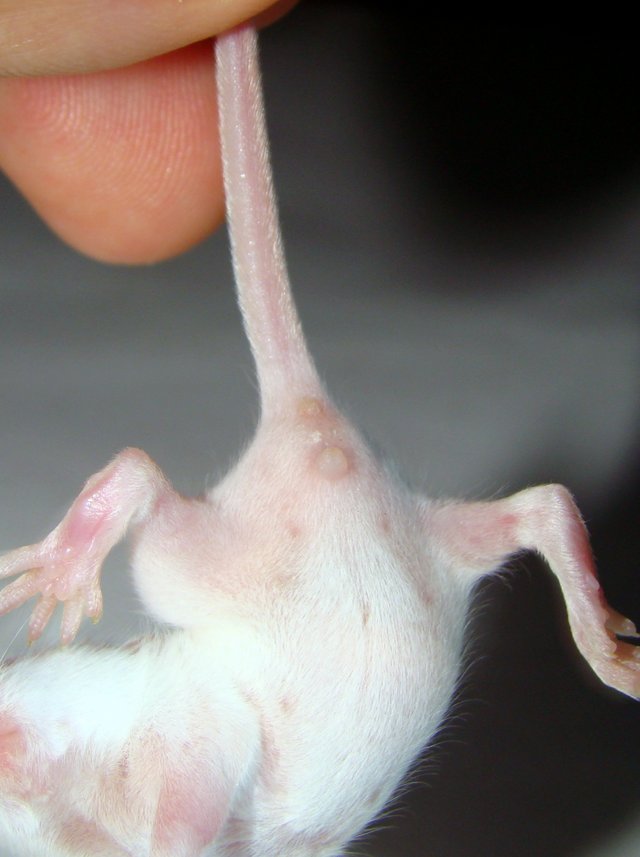Practical Lab Mice Care Tips
Have you previously experimented on mice, or will you do so in the future? Standards on treatment of the mice vary from lab to lab, but in case you run a lab or are able to give your input on how to control for variables before you get the tests up and running then this might be of interest to you.
You don’t have to invent the wheel to put one in a cage
If you were cooped up all day in a shoebox I’m sure you’d want to get some exercise too. Contrary to what people might have assumed, mice don’t just run in wheels when they’re stressed. Access to wheels lowers their stress levels and improves their fitness and health, which is why they've started gaining use in more lab studies.
Researchers set up a location with a wheel, mouse food, and automated sensors and cameras to see if wild mice liked running. They went over 3 years of accumulated videos and noted which animals came to visit and how long they ran on the wheels for. Wild mice ran on the wheel, and they kept coming back to run even when they took away the food. Even mice that had to have been born after they took away the food were coming around to run on the wheel.
The only animals tested here that love running more than slugs are mice. Wait... slugs? How do they run?

By Johanna H. Meijer and Yuri Robbers (https://dx.doi.org/10.1098/rspb.2014.0210) [CC BY 3.0], via Wikimedia Commons
You’d snack all the time if you were bored out of your mind
So why assume that mice won’t if they’re locked up in solitary and given an all-you-can-eat buffet for breakfast, lunch, and dinner? Keep your mice fit and your data might too. Fat rats and fat mice make for rather poor baseline test subjects. Ad libitum (that's pig Latin for eat as much as you want all the freakin' time) feeding should be avoided and set feeding schedules should be set up instead so as to restrict the total caloric intake of the animals.
That is, of course, unless you want all your lab animals to have a predisposition to increased developments of various cancers, obesity, insulin resistance and diabetes, impacted immune systems and chronic inflammation, accelerated onset and development of neurodegenerative disorders, and shorter lives. Do those sound familiar at all? They should, that's the laundry list of things humans also set themselves up for if they were to post up at their local buffet 24/7.
Black-6 are a bit like gingers and feel pain differently, actually all mice strains tested are unique in pain response
Are you running an experiment where you are inducing or relieving pain in mice? Black-6 might not be the right choice. They’re kind of a wimp when it comes to pain tolerance and how they respond to pain from things like heat or cold, and they have strange reactions in general. Much like how red-headed humans experience pain differently, so too does the overly-commonly used Black-6 strain, who were the oddest of the 11 strains tested, yet they are by far the most popular strain used in mouse studies.
A prototypical millennial suffering from copious amounts of existential pain

By Pillefaxe [CC BY-SA 3.0], from Wikimedia Commons
Don’t gender-swap your researchers
Another thing to keep in mind when doing a pain or stress study is what the sex of the researcher handling the mice is. Mice register lower levels of pain when exposed to the scent of human males, because they get stressed out when they smell them. That stress response includes stress-induced analgesia, which means that mice have a natural tendency to release natural painkillers when they can smell dudes.
I would also want a natural pain-inhibition reaction if I smelled that.

By Tallguy1982 [Public domain or CC0], from Wikimedia Commons
Females are underrepresented, don’t be discriminatory
Don’t just use one sex, experiment on both! Just like how human female test subjects were underrepresented in drug trials for decades, so too has there been a skewed ratio of male and female animal test subjects. And to no one's surprise female mice sometimes behave differently and occasionally respond to some drugs differently, yet out of 1200 or so papers only 42% reported the sex of the lab animals, and of those that reported the sex only 24% used females.
Don't just slice and dice the men in your life, uh, I mean study

By Pogrebnoj-Alexandroff (open free cources) [CC BY-SA 3.0], via Wikimedia Commons
Mice and old people get grumpier at night
Scientists pinpointed and controlled a cell circuit between circadian rhythm in the suprachiasmatic nucleus and the ventromedial hypothalamus, which is part of what mediates aggression in the brain. There are a couple of implications here. First, if you’re studying the behavior of mice make sure that key parts of the study don’t terminate at different times of day when your mice might be feeling a bit moodier. And second, this better explains why dementia and Alzheimer’s patients have been reported to get agitated when the sun starts going down, a process known as sundowning, and eventually offer a way to alleviate that process pharmaceutically.
Lab mice are typically only this happy during the day

By Nugetss [CC BY-SA 3.0], from Wikimedia Commons
Mice gut microbiota varies from vendor to vendor, cage to cage, and individual to individual
A side-effect of eating each others’ poop might be boosting their immune systems and gut biodiversity. But if none of their adjacent neighbors have resilient gut microbiota, then your results might be a bit off. They got mice from four different vendors and saw how they responded to Plasmodium, which are parasites that can cause malaria. They tried out different feed types and there were slight differences in how they fended the parasites off, but posited the majority of the responses to fighting the infection were mostly due to the different pre-existing gut microbiota the mice had when they got them from the vendors.
They went as far as to give the mice yogurt cultures to see how that would help. Turns out that probiotics as found in yogurt actually did help the little rodents fend off the disease-causing eukaryotes, though they weren't complete cures. Buying your mice from the wrong vendor might give you poor results from their lack of diverse enough gut microbiota to accurately represent a healthy enough specimen that is equipped with the right gut equipment necessary to fight off infections. Also, don't take this as me saying that you should just eat yogurt in case you get malaria. See a doctor.
Handle with care
Don’t pick mice up by the tail! This alone can trigger anxiety and mess up your study. A gentle touch is necessary to ensure your mice aren’t skittish creatures by default. They'll love you and appreciate you more if you put tunnels in their cages that they can get used to which you can then use to retrieve them out of their cages with. Even using a tunnel to get them when they haven't previously been exposed to tunnels is still preferable to just yanking them out by their tails.
Some strains like shared tunnels more than others, but all strains agree in saying that whoever picks them up by the tail is a big meanie they don't want to associate with.
plz no

By Pogrebnoj-Alexandroff (free open public sources) [CC BY 3.0], via Wikimedia Commons
Sources
“Control” laboratory rodents are metabolically morbid: Why it matters
Heritability of nociception I: Responses of 11 inbred mouse strains on 12 measures of nociception
Redheads feel a different kind of pain
Male Scent May Compromise Biomedical Research
We need more furry females in medical research
Researchers Discover Connection Between Circadian Rhythm and Aggression
Composition of the gut microbiota modulates the severity of malaria
Reducing Mouse Anxiety during Handling: Effect of Experience with Handling Tunnels
#steemSTEM has cool people who like, create, and support nerd stuff like Science, Technology, Engineering, and Mathematics related content and activities on the STEEM blockchain. If you want to be a part of it you can contribute relevant STEM content with the #steemstem tag, support and vote on steemSTEM authors, join the curation trail, hop in the Awesome Discord Channel, and delegate SP to steemSTEM.
50 SP| 100 SP| 500 SP| 1000 SP| 5000 SP| 10000 SP| 50000 SP

Not always. Additionally sex specific differences in drug effects don't always carry over between species.
True, guess I was just trying to say that there is always a possibility that they may react to certain drugs differently, and you're right, just because something shows a difference in one species doesn't mean that'll be true of another. Edited the wording in the article a bit, thank you!
It's definitely something that one does have to consider during drug development. In fact it's something that we do consider at my company, honestly we try to look at the data we have from every possible angle when looking at both on target and off target effects for what ever compound we are using.
Sex specific effects are also prominent in how compounds interact with the various CYPs. This is due to the sexual dimorphism of the expression of various liver enzymes (see here: https://www.ncbi.nlm.nih.gov/pmc/articles/PMC2713118/). These differences in expression levels can lead to vastly different pharmakokinetics of drugs and differences to effecacy/tolerability.
I want to state all this too, because your point was a good one, it's just biology is so exceedingly complex, and this is another reason why testing in so many different animal models is essential during the early stages of drug development. The models are quite different, and even the sexes of each model organism can have further differences. Making prediction of tolerability in humans ... Hard.
This is a beast of a paper, but it makes a lot of sense so far. And holy sh that is a lot of references. Would be cool to eventually write a review or something of this magnitude...
Most reviews have a lot of references, I've only ever authored one, and had over 100 references for 6 pages of text.
Is this partly due to the ability to grab articles on the internet? I can't imagine it hasn't gotten faster to grab references now with how efficient search is. I've seen reviews with 700+ references and I'm just like, no way someone would have done that in the age of hard copies... would they?
I always use hard copies and read references I site. I like to highlight with my hand and I struggle to retain as much if I read on a screen for one reason or another.
Can't justify 700 references, that seems excessive. :D
https://www.scientificamerican.com/article/reading-paper-screens/
The science seems to agree with you, it's easier to remember what you've read or written on physical paper than digital copies.
Yeah it was a quite nuts review on autism, seemed a bit autistic to me to put that many in but it was pretty thorough to say the least.
Hey good job man! That's some interesting stuff.
To be honest with you I don't think I would ever buy one of those as I don't think it would enjoy living in a cage in my bedroom, however I found your post informative and appreciate your efforts.
lmfao
Nature can be tricky!
Have a good day!
Oh hey thanks bro!
Yeah I don't think I could ever house animals unless I had a huge house or something and could make a giant tunnel network or something they could run around in, and they're very social animals so I definitely wouldn't want a solo rodent stuck in a cage.
Lol, there's gotta be something to it, maybe our own incessant hand-washing and hygiene routines have contributed to the speculated hygiene-related health issues. Much less transmission of poo-related diseases, but less gut microbiota diversity is the tradeoff, and I think we're seeing that in individuals with increasing rates of immune or gut-related issues that were less common in the past.
Have a great one yourself!
Is was just having a look at the methods of the paper on which part of the Male scent may compromise Biomedical research article is based. -> https://www.nature.com/articles/nmeth.2935#methods It is seems that the test group consisted out of max 20 mice or am I reading it wrong?
This is my usual complain about many of such studies: small samples and no error bars :)
level of rigour: biology < chemistry < physics < mathematics :D
I beg to disagree. Chemists do a reaction once and publish. n=1 ain't rigor.
Mathematics is almost free to do, paper and a pencil cost less then a mouse or human.
On a side note: biology is the most interesting of those fields ;D
Well a super computer for rigorous numerics is at least more expensive than a mouse :)
Still cheaper in the long or short run then a mouse program.
Do you have access to those new nvidia gpus? They seem disgustingly powerful, I would imagine a lot of bio firms are picking some up.
Small sample sizes is how mouse studies are done. 20 mice is standard for an individual published study. (They are expensive as well).
You also don't know how many other studies we're done to establish conditions for this final one. :)
I know that for this field, getting large samples is a problem. What I actually meant is that as long as the error bars are correctly handled, I am happy (we discussed this a lot in the past ;)). However, for many studies, the errors are not very nicely evaluated and for small samples, statistical uncertainties matter a lot.
Eh, I tend to disagree with your desire for physics level error propagation on biological samples. It's both unnecessary and would be a drastic hindrance to the development of things which save people's lives. I think in geberal physics has taught you to be a bit too picky! ;)
It is just a fair estimate of the uncertainties on any measurement. I don't say one should need 5 sigmas before claiming anything in biology. But what about quoting the 1 sigma statistical uncertainty as a systematics way of working? What is wrong in admitting there is an error associated with any measurement (and any prediction in fact too)?
I don't think anyone argues the prevalence of error in biology. Its just an inherent difficulty in studying a living system. :)
But the good thing is that more and more people are trying to incorporate some error somehow. Or a least be slightly more critical.
Uh, I don't know, I just know it's a study with Mogil and he's the one who led a lot of pain-related research including the other cited one with the 11 mice strains, so I wouldn't imagine he's one to not be thorough.
The test groups presented in the methodology of that paper are small.
I guess, I can see they commented in the additional data pdf that they only used 1 person for a part of the study citing the difficulty of doing it with more people. I see what you're saying though, I'd prefer research that has lots of subjects as opposed to fewer individuals.
Maybe it is good to add to the post that the test groups for this part of the research were a bit small. :)
To be fair they are frequently small, I have not really seen many such footnotes in other steemstem articles and for brevity's sake I did not want to just repeat the entire methodologies of each study cited.
Are people making these custom footers for steemstem, or are they from a template somewhere or some resource base? Yours for example is really nice.
I didn't know that such small test groups were the standard.
Just check the page source and then you can get to the underlying html
Unfortunately lots of studies have small groups used due to cost and time limitations, though it would be preferable to use more, it's not necessarily within the ability of many labs to do so.
Sweet, now I grew a foot.
Hi @charitybot!
Your post was upvoted by utopian.io in cooperation with steemstem - supporting knowledge, innovation and technological advancement on the Steem Blockchain.
Contribute to Open Source with utopian.io
Learn how to contribute on our website and join the new open source economy.
Want to chat? Join the Utopian Community on Discord https://discord.gg/h52nFrV
Very fascinating exposition. Not all people doing experiments are aware of these unique revelations. Very informative post.
Regards
@eurogee
Thanks eurogree! I hope it was interesting.
My Cat :)
